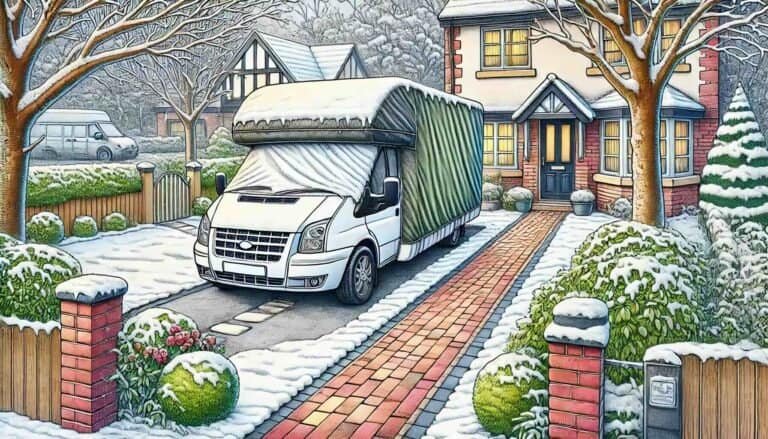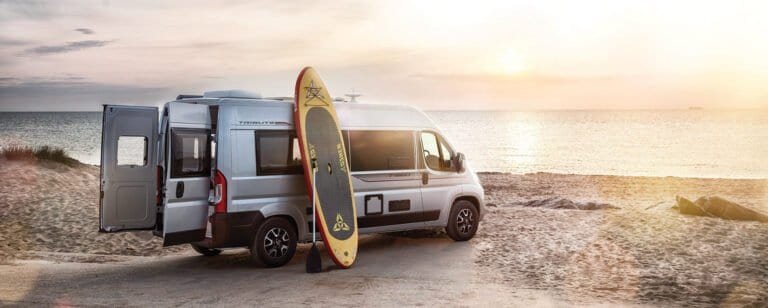Owning a campervan or motorhome is an incredible way to explore the great outdoors with all the comforts of home. However, like any vehicle, they require regular maintenance to ensure they run smoothly and safely. Proper maintenance not only extends the life of your campervan but also helps avoid costly repairs down the road. This article will explore common maintenance issues and provide practical solutions to keep your campervan or motorhome in top condition.
Electrical System Issues
Battery Problems
Common Issues:
Battery problems are one of the most frequent issues faced by campervan owners. These can range from a dead battery to corroded terminals, which can cause a loss of power or difficulty starting the vehicle.
Solutions:
- Regular Checks: Regularly check the battery’s charge level using a multimeter. Ensure it’s fully charged before long trips.
- Clean Terminals: Inspect and clean the battery terminals to prevent corrosion. Use a mixture of baking soda and water to clean any build-up, and apply petroleum jelly to the terminals to prevent further corrosion.
- Proper Storage: If your campervan is not in use for an extended period, remove the battery and store it in a cool, dry place. Use a trickle charger to maintain the battery charge.
Lighting Malfunctions
Common Issues:
Burnt out bulbs or faulty wiring can lead to lighting malfunctions in your campervan, affecting both interior and exterior lights.
Solutions:
- Replace Bulbs: Regularly check all lights and replace any burnt-out bulbs. Keep spare bulbs on hand for quick replacements.
- Inspect Wiring: If replacing the bulb doesn’t solve the problem, inspect the wiring for any signs of wear or damage. Repair or replace damaged wires as needed.
- Upgrade to LED: Consider upgrading to LED lights, which are more energy-efficient and have a longer lifespan.
Appliance Failures
Common Issues:
Appliances such as the fridge, stove, or heater can sometimes fail due to electrical issues or wear and tear.
Solutions:
- Regular Servicing: Schedule regular servicing for your campervan’s appliances to ensure they are in good working condition.
- Check Connections: Ensure all electrical connections are secure and free of corrosion. Loose or corroded connections can cause appliances to malfunction.
- Read the Manual: Always refer to the manufacturer’s manual for specific troubleshooting tips and maintenance guidelines.
Mechanical and Engine Problems
Engine Overheating
Causes:
Engine overheating is a common problem that can be caused by low coolant levels, a faulty radiator, or a malfunctioning thermostat. Overheating can lead to serious engine damage if not addressed promptly.
Solutions:
- Check Coolant Levels: Regularly check and top up the coolant levels in your campervan. Always use the coolant type recommended by the manufacturer. Make it a habit to check the coolant level before long trips.
- Inspect the Radiator: Ensure the radiator is clean and free of debris. Over time, dirt and grime can build up, restricting airflow and causing the engine to overheat. Look for any signs of leaks or damage, and repair or replace the radiator if necessary.
- Monitor the Thermostat: A malfunctioning thermostat can prevent coolant from flowing properly, leading to overheating. If your engine frequently overheats, consider replacing the thermostat. This is a relatively inexpensive fix that can prevent more severe issues.
Brake Issues
Common Problems:
Brake problems, such as worn brake pads or brake fluid leaks, can significantly impact your vehicle’s safety. Regular brake maintenance is essential to ensure your campervan stops safely.
Solutions:
- Regular Inspection: Regularly inspect the brake pads for wear and replace them when they become too thin. Worn brake pads can reduce braking efficiency and damage the brake rotors. Check the manufacturer’s guidelines for the recommended thickness.
- Check Brake Fluid Levels: Ensure the brake fluid is at the proper level. Low brake fluid can indicate a leak or worn brake components. Look for any signs of leaks around the brake lines and calipers and repair them immediately.
- Test Brakes: Periodically test your brakes to ensure they are working correctly. Listen for any unusual noises or vibrations when braking, as these can be signs of worn brake pads or other issues.
Suspension Problems
Common Issues:
Suspension problems can manifest as worn-out shocks or alignment issues, leading to a bumpy ride, poor handling, and uneven tyre wear.
Solutions:
- Regular Checks: Regularly inspect the shocks and struts for signs of wear or damage. If you notice excessive bouncing or a rough ride, it may be time to replace the shocks.
- Alignment Servicing: Ensure your campervan’s wheels are properly aligned. Misalignment can cause uneven tyre wear and affect handling. Have the alignment checked and adjusted during regular service intervals.
- Monitor Ride Quality: Pay attention to how your campervan handles on the road. If you notice any changes in ride quality or handling, have the suspension system inspected by a professional.
Exterior and Interior Maintenance
Leaks and Water Damage
Causes:
Leaks can occur due to faulty seals, roof damage, or poorly fitted windows and doors, leading to water damage inside your campervan. Water damage can cause mould, mildew, and structural damage if not addressed promptly.
Solutions:
- Inspect Seals: Regularly inspect all seals around windows, doors, and roof vents. Replace any seals that are cracked or damaged. Use a high-quality sealant to ensure a watertight seal.
- Repair Roof Damage: Check the roof for any signs of damage or wear. Small cracks or holes can lead to significant leaks. Repair or replace damaged areas promptly to prevent further damage.
- Use Sealant: Apply a high-quality sealant to any potential leak points, such as around roof vents, skylights, and seams. This helps ensure a watertight seal and prevents water from entering the campervan.
Tyre Wear and Tear
Common Issues:
Uneven tyre wear and low pressure can lead to poor handling, reduced fuel efficiency, and increased risk of blowouts.
Solutions:
- Check Tyre Pressure: Regularly check the tyre pressure and inflate the tyres to the recommended levels. Properly inflated tyres improve fuel efficiency, handling, and tyre lifespan.
- Rotate Tyres: Rotate the tyres regularly to ensure even wear. Uneven wear can lead to poor handling and reduced tyre life. Follow the manufacturer’s guidelines for rotation intervals.
- Inspect for Damage: Look for any signs of damage, such as cuts, bulges, or embedded objects, and replace damaged tyres promptly. Regularly inspect the tread depth to ensure the tyres provide adequate traction.
Interior Wear and Tear
Common Problems:
Interior issues, such as upholstery damage and appliance wear, can detract from your campervan’s comfort and functionality. Keeping the interior well-maintained ensures a pleasant living space during your travels.
Solutions:
- Regular Cleaning: Keep the interior clean to prevent dirt and grime from causing wear and tear. Use appropriate cleaning products for different surfaces, such as upholstery, countertops, and flooring.
- Repair or Replace: Repair or replace any damaged upholstery, flooring, or fixtures to maintain a comfortable living space. Consider using durable materials that can withstand the rigours of travel.
- Service Appliances: Ensure all interior appliances are regularly serviced and maintained according to the manufacturer’s guidelines. This includes the fridge, stove, heater, and any other appliances in your campervan.
Conclusion
Regular maintenance is crucial to keep your campervan or motorhome in top condition and ensure a safe and enjoyable travel experience. By addressing common issues and following the solutions provided, you can prevent major problems and extend the life of your vehicle. Remember, if you encounter issues beyond your expertise, it’s always best to seek professional help.
FAQs
What are the most common electrical issues in campervans?
The most common electrical issues in campervans include battery problems, lighting malfunctions, and appliance failures. Regular checks and maintenance can help prevent these issues.
How often should I check my campervan’s brakes?
It’s advisable to check your campervan’s brakes at least every six months or before any long trips. Regular inspections help ensure your brakes are in good working condition.
What’s the best way to prevent tyre wear?
To prevent tyre wear, regularly check tyre pressure, rotate tyres according to the manufacturer’s recommendations, and inspect for any signs of damage.
How do I fix a leaking roof in my motorhome?
Fixing a leaking roof involves inspecting the roof for damage, repairing or replacing damaged areas, and ensuring all seals around roof vents and fixtures are intact. Using a high-quality sealant can also help prevent leaks.
When should I seek professional maintenance for my motorhome?
Seek professional maintenance when you encounter issues beyond your expertise or when regular maintenance tasks require specialised tools and knowledge. This includes engine problems, major electrical issues, and complex mechanical repairs.
How can I maintain the battery life of my campervan?
To maintain battery life, regularly check the charge level, clean the terminals to prevent corrosion, and use a trickle charger if storing the campervan for an extended period. Removing the battery during long storage periods can also help.
What should I do if my campervan’s appliances stop working?
If your campervan’s appliances stop working, first check the electrical connections and fuses. If the issue persists, consult the appliance’s manual for troubleshooting tips or schedule a professional servicing.
How can I prevent engine overheating in my campervan?
Prevent engine overheating by regularly checking coolant levels, inspecting the radiator for debris or leaks, and ensuring the thermostat is functioning correctly. Keeping the engine well-maintained is key.
What are signs that my campervan’s suspension needs attention?
Signs that your campervan’s suspension needs attention include excessive bouncing, a rough ride, and uneven tyre wear. Regularly inspect the shocks and struts for wear and have the alignment checked.
How do I deal with mould and mildew inside my campervan?
Deal with mould and mildew by thoroughly cleaning the affected areas with a mixture of water and vinegar or a specialised mould cleaner. Ensure proper ventilation and address any leaks or water damage to prevent recurrence.
What are the risks of ignoring regular campervan maintenance?
Ignoring regular maintenance can lead to severe issues such as engine failure, brake problems, and extensive water damage, resulting in costly repairs and potentially unsafe travel conditions.
How often should I rotate my campervan’s tyres?
Rotate your campervan’s tyres every 8,000 to 13,000 kilometres, or according to the manufacturer’s guidelines. Regular rotation ensures even wear and extends tyre life.
What are the benefits of upgrading to LED lights in my campervan?
Upgrading to LED lights offers benefits such as improved energy efficiency, longer lifespan, brighter illumination, and reduced heat output, making them ideal for both interior and exterior lighting.
How can I maintain the exterior of my campervan?
Maintain the exterior by regularly washing and waxing the campervan, inspecting and repairing any damage, and applying a high-quality sealant to prevent leaks. Regular maintenance keeps the campervan looking good and protects against environmental damage.
What should I include in my campervan maintenance kit?
A campervan maintenance kit should include basic tools (screwdrivers, pliers, wrenches), spare bulbs, fuses, a multimeter, cleaning supplies, sealant, tyre pressure gauge, spare tyre, and emergency repair items like duct tape and a portable battery charger.







